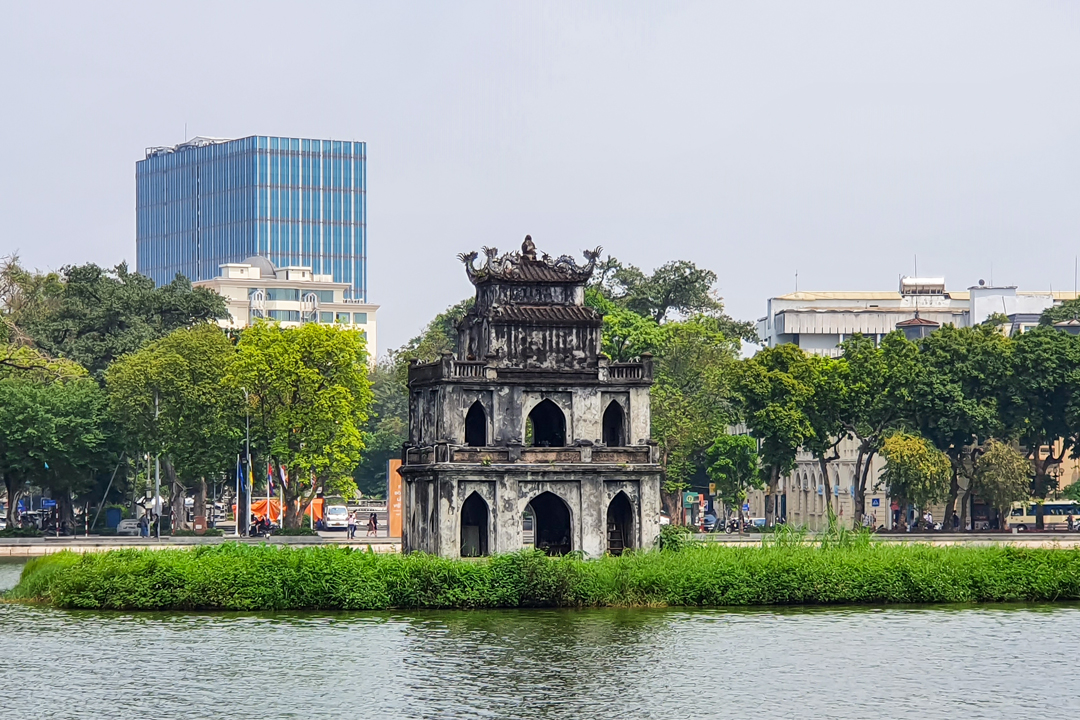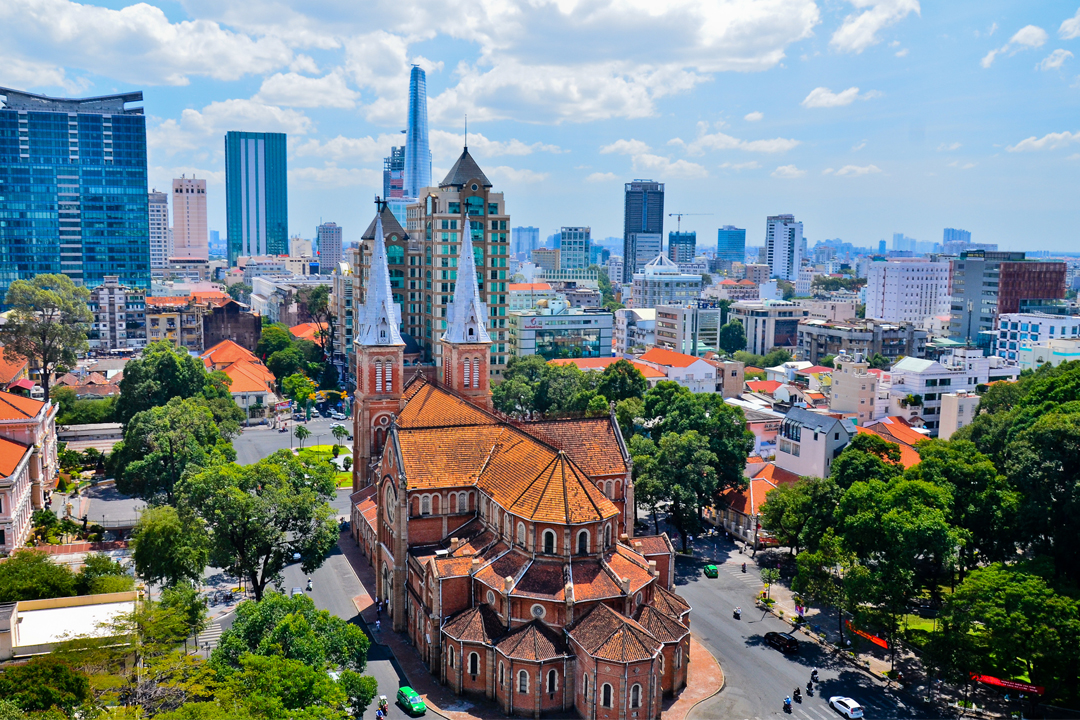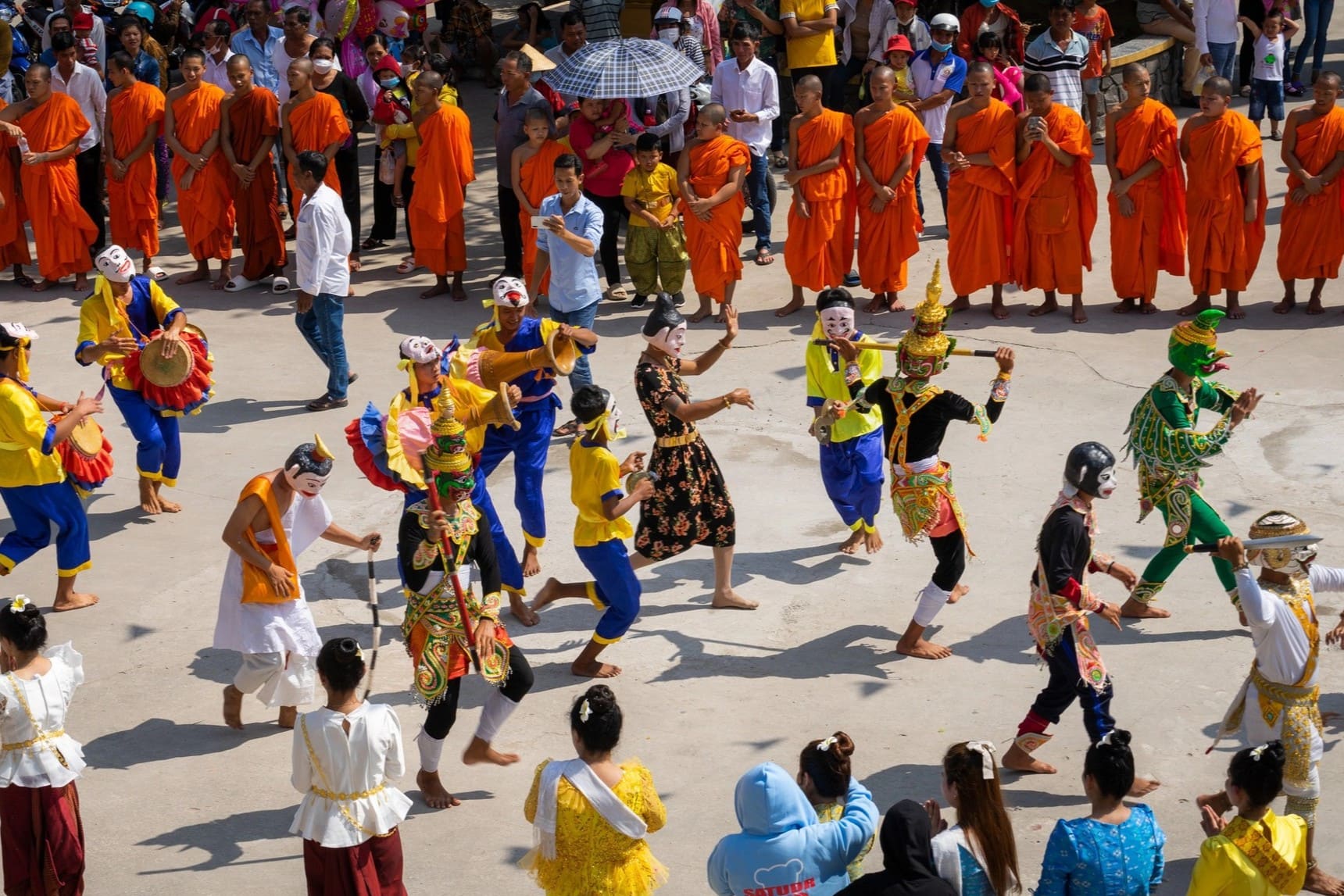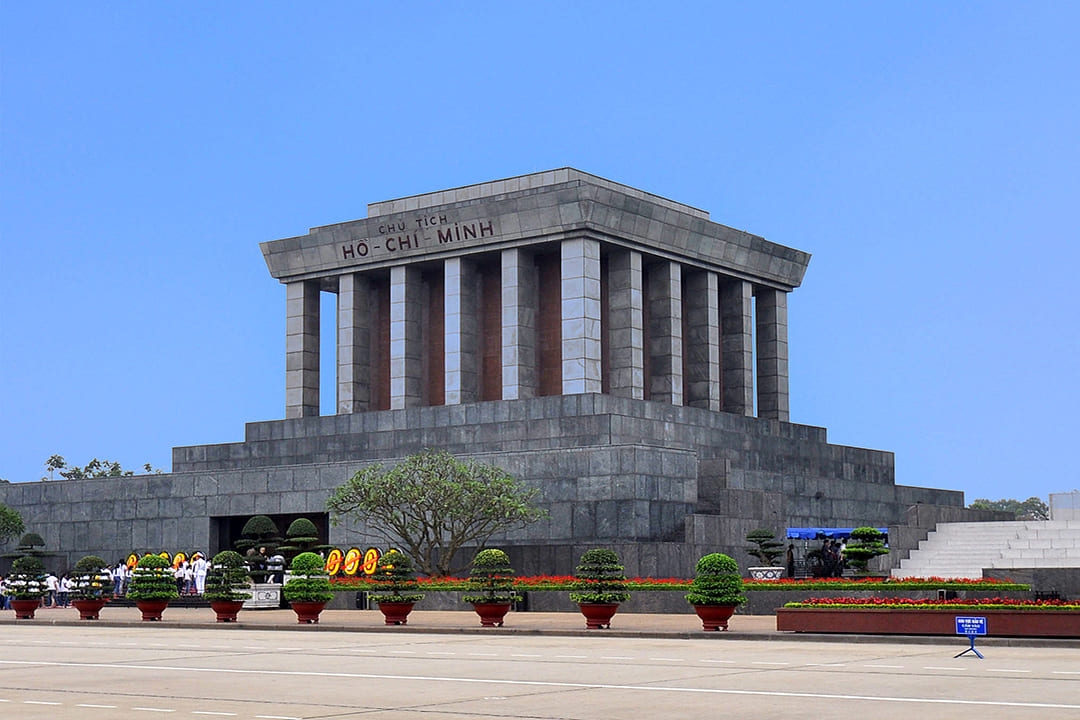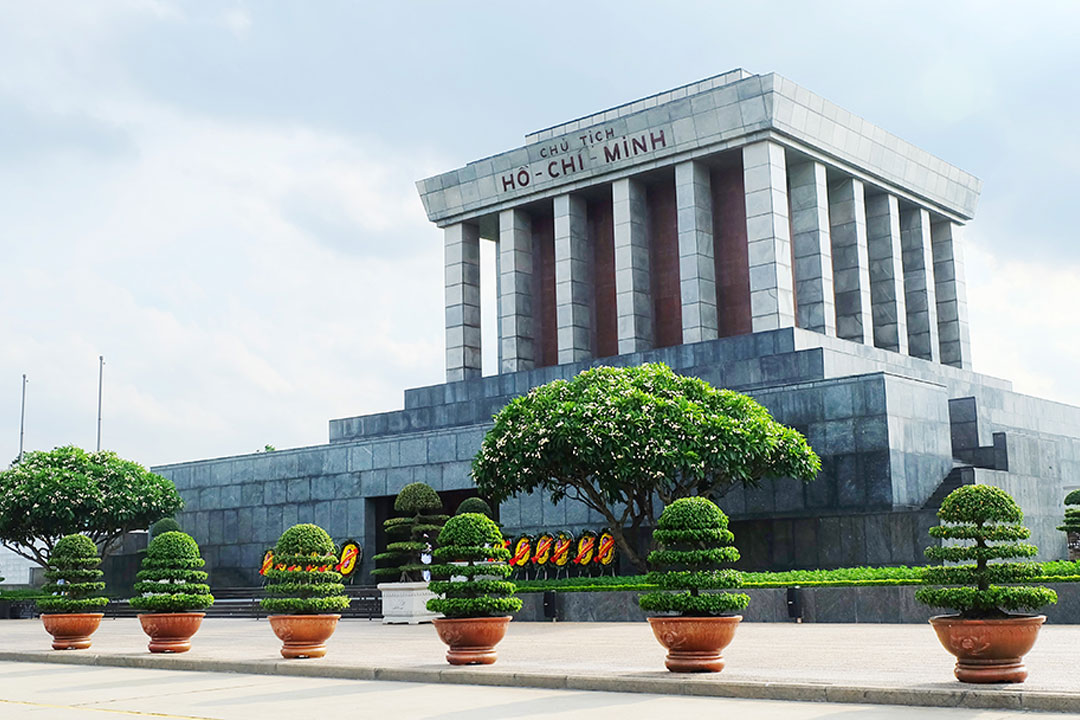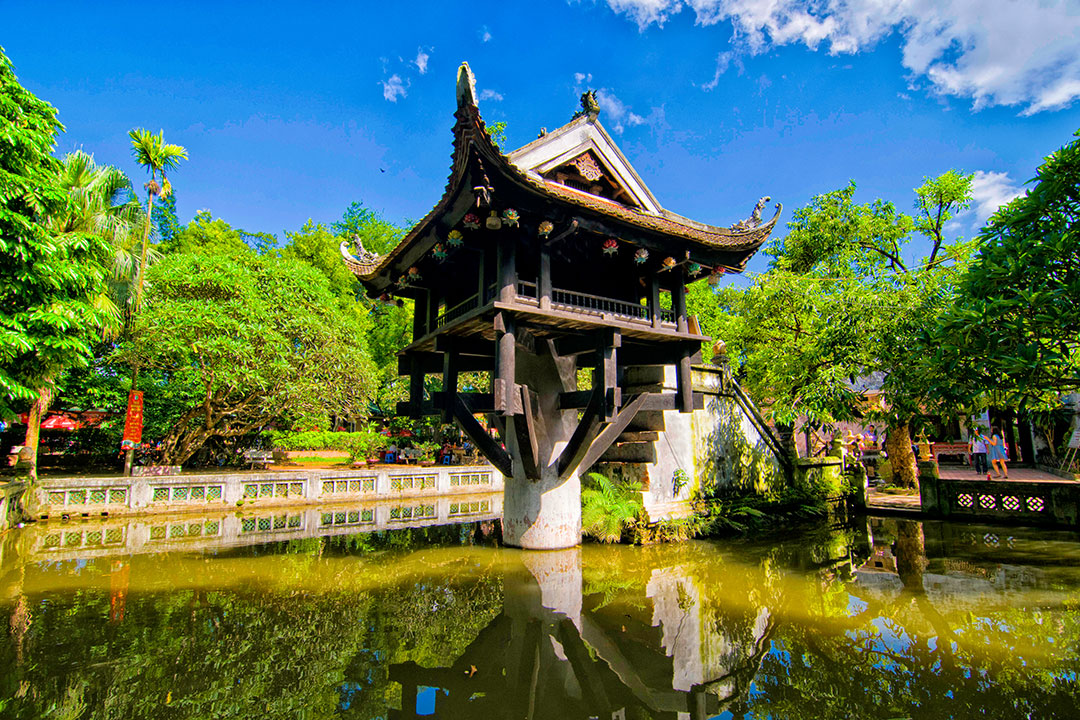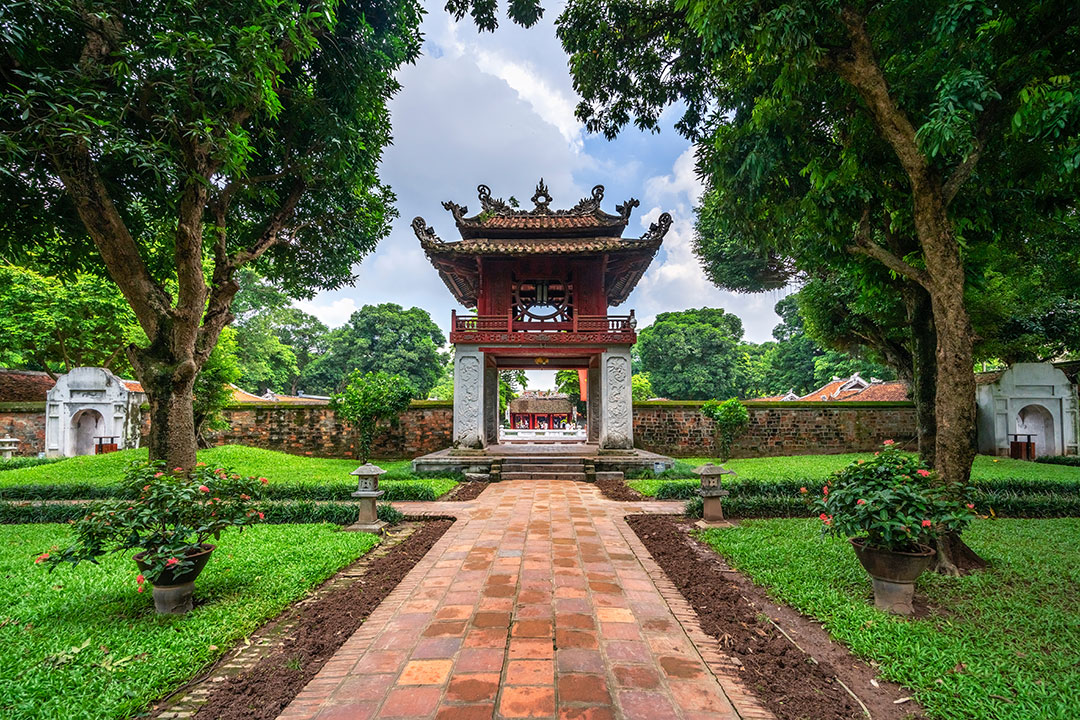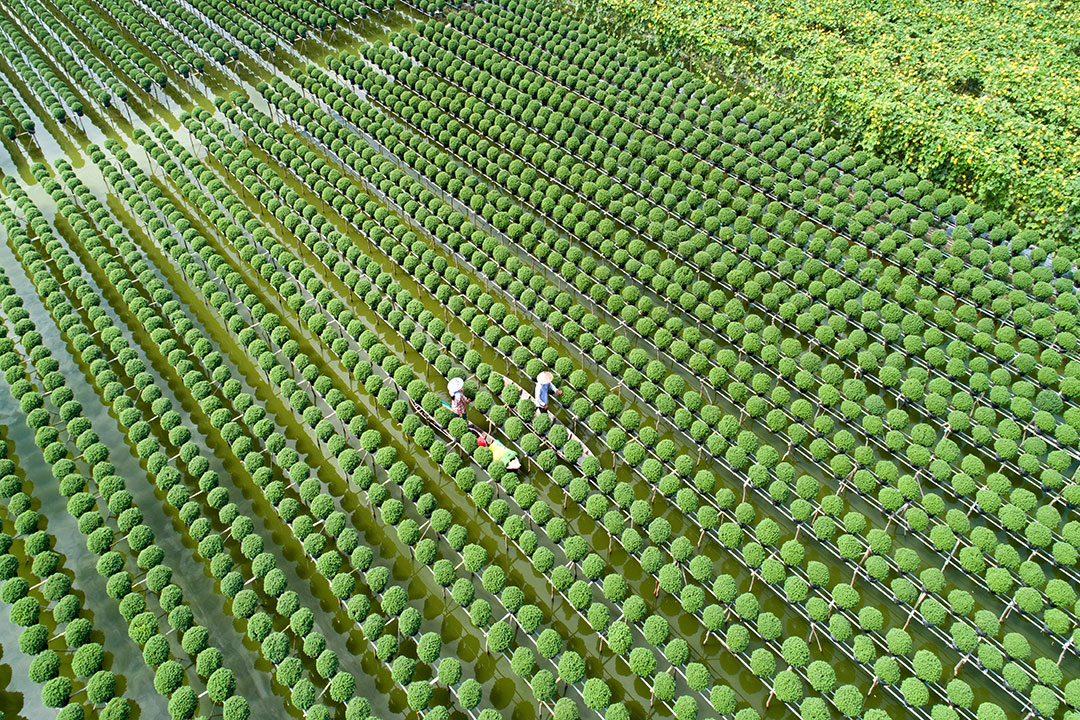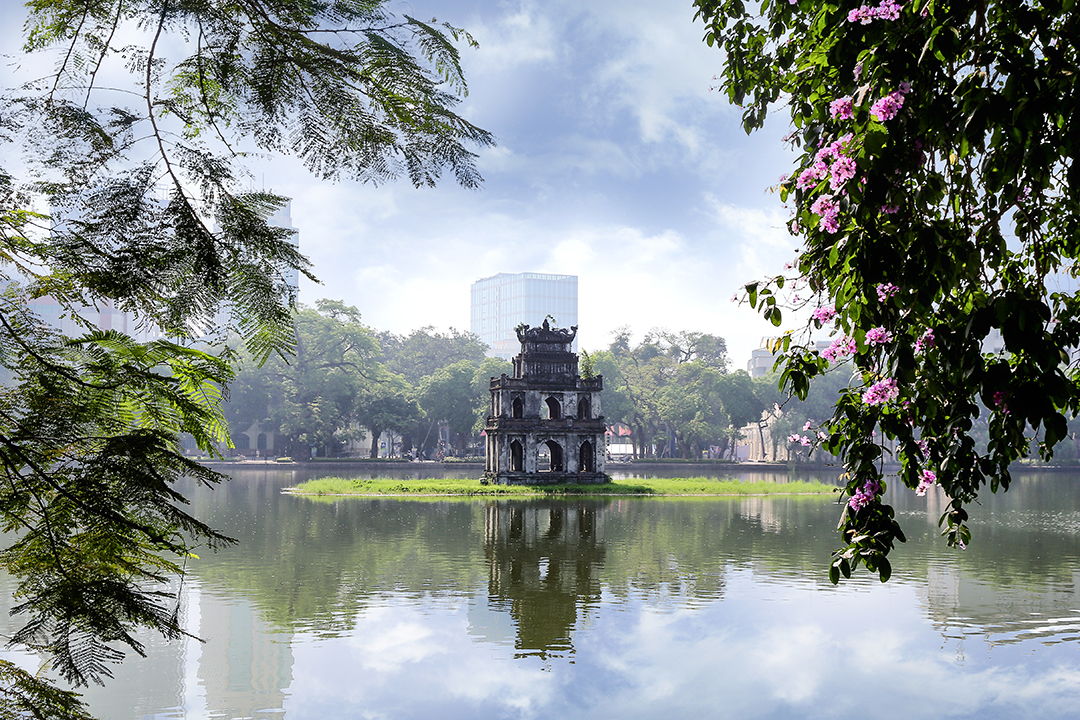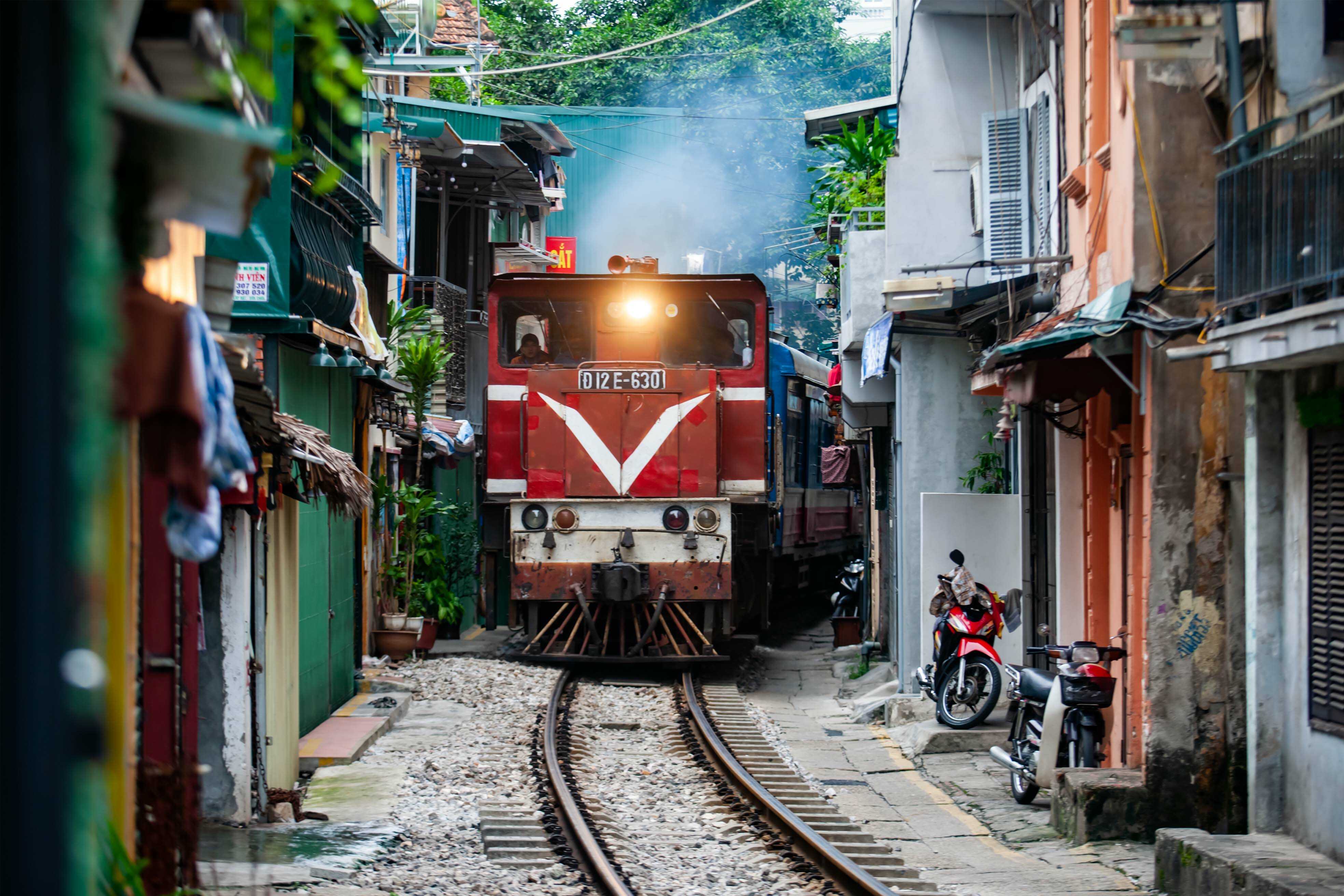Ho Chi Minh Mausoleum: Guide To History, Architecture, Visiting Tips & Must-See Experiences
Rising majestically at Ba Dinh Square, the Ho Chi Minh Mausoleum stands as Vietnam's most revered monument. This granite edifice houses the preserved body of the revolutionary leader who led the nation to independence. The structure blends Soviet architectural influences with traditional Vietnamese elements, offering visitors a window into Vietnam's national soul.
Introduction to the Ho Chi Minh Mausoleum
The Ho Chi Minh Mausoleum represents not just an architectural achievement but a profound symbol of national identity, reverence, and historical significance. This imposing granite structure houses the preserved remains of Vietnam's most beloved leader and draws millions of tourists annually. Before planning your visit to this iconic landmark, understanding its location, cultural importance, and practical visiting information will ensure a meaningful and respectful experience.
Where is Ho Chi Minh Mausoleum?
Location: 1 Hung Vuong Street, Ba Dinh Ward (1 Hung Vuong Street, Dien Bien Ward, Ba Dinh District, Hanoi)
The Ho Chi Minh Mausoleum occupies a prominent position overlooking the historic Ba Dinh Square. This is where President Ho Chi Minh read the Declaration of Independence on September 2, 1945. The mausoleum stands as the centerpiece inside the Complex of President Ho Chi Minh. The complex is a sprawling 35,000-square-meter area encompassing several historically significant buildings and carefully landscaped gardens.
The mausoleum's location is deliberately symbolic, situated at the focal point of Ba Dinh Square, the building faces the Party Central Committee Office and stands near other important government buildings. The surrounding gardens feature plants from different regions of Vietnam, symbolizing the country's unity and diverse natural beauty. For tourists navigating Hanoi, the mausoleum serves as both a physical and symbolic landmark, representing the heart of Vietnamese national identity and pride.
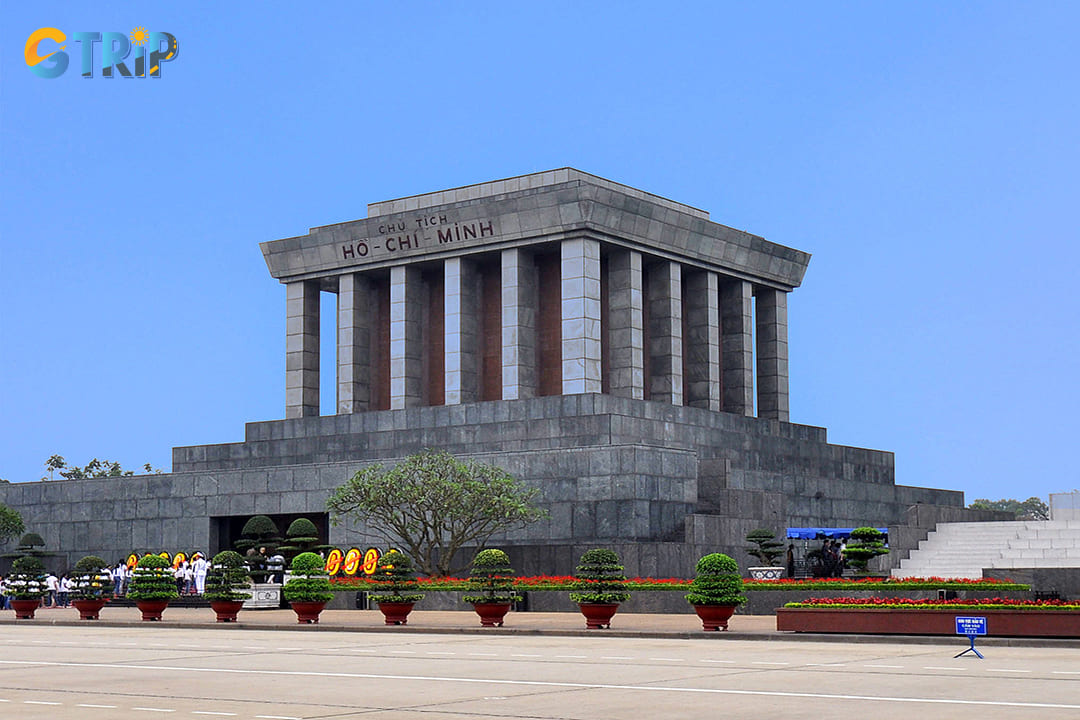
The Ho Chi Minh Mausoleum stands as the centerpiece inside the Complex of President Ho Chi Minh
Why visit the Ho Chi Minh Mausoleum?
The Ho Chi Minh Mausoleum is a highlight of any Hanoi tour, offering a powerful look into Vietnam’s revolutionary history and enduring national identity. The structure blends traditional Vietnamese elements with Soviet-inspired monumental architecture, symbolizing the historical ties between the two nations. Built with granite from Ho Chi Minh’s birthplace and rare materials from across the country, it stands as a tribute to unity and respect. For international travelers, the mausoleum provides important context for understanding Vietnam’s political evolution and the legacy of its most iconic leader.
What makes the experience truly memorable is the atmosphere of reverence. Many Vietnamese people queue for hours to pay their respects, reflecting a deep emotional bond that endures despite the country’s rapid modernization. You can also witness the ceremonial changing of the guards, a rare example of socialist memorial traditions still practiced today. With its solemn rituals, striking architecture, and historical depth, the Ho Chi Minh Mausoleum offers both a cultural and emotional journey at the heart of Hanoi.
Other information: Entrance fees, opening hours, and accessibility
Entrance fees:
- General admission: Free for all visitors
- Guided tours: Available at nominal fees through official tour operators
- Special exhibitions: Occasionally held with separate ticketing
Seasonal opening hours:
| Time | Days | Hours |
|---|---|---|
| April 1 - October 31 | Tuesday, Wednesday, Thursday | 7:30 AM - 10:30 AM |
| Saturday, Sunday, Holidays | 7:30 AM - 11:00 AM | |
| November 1 - March 31 | Tuesday, Wednesday, Thursday | 8:00 AM - 11:00 AM |
| Saturday, Sunday, Holidays | 8:00 AM - 11:30 AM |
Closure information:
- Closed on Mondays and Fridays year-round
- Exceptions made for special national holidays (May 19, September 2, and Lunar New Year's Day) if they fall on a Monday or Friday
- Annual closure for approximately two months (typically September-November) for maintenance and preservation work on Ho Chi Minh's body
Accessibility considerations:
- Wheelchair access: Limited, with some ramps available at entrance points
- Distance walking required: Moderate, approximately 300-500 meters from entrance to mausoleum
- Elderly considerations: Long queues with limited shade can be challenging during summer months
The mausoleum maintains excellent conservation standards, with regular maintenance ensuring its preservation as a national monument. The facility employs specialists trained in Soviet preservation techniques, and the building undergoes periodic restoration to maintain its architectural integrity. Security is extremely tight, with armed guards maintaining a respectful and solemn atmosphere throughout the complex. For the optimal experience, you should arrive early (ideally 30-45 minutes before opening) to avoid the longest queues, particularly during Vietnamese holiday periods.
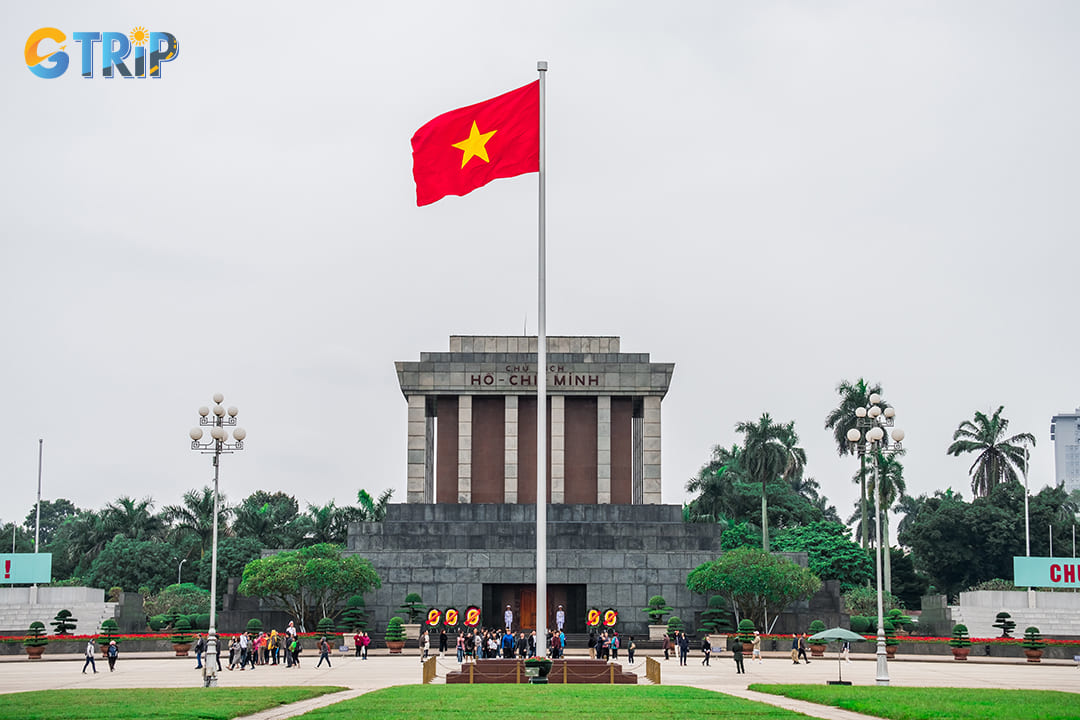
The Ho Chi Minh Mausoleum is a highlight of any Hanoi tour, offering a powerful look into Vietnam’s revolutionary history and enduring national identity
Who is Ho Chi Minh? The great old father of the Vietnamese people
Ho Chi Minh, affectionately known as “Uncle Ho” or “the great old father”, is one of Vietnam’s most revered leaders. Ho Chi Minh (born Nguyen Sinh Cung in 1890, Nghe An Province) is considered the father of modern Vietnam. A revolutionary leader and statesman, he served as President of North Vietnam from 1945 until his death in 1969. From a young age, he was exposed to anti-colonial ideas and later traveled widely, working in Europe and the U.S. His time abroad shaped his political vision. In 1930, he founded the Indochinese Communist Party and became a driving force behind Vietnam’s independence movement. He led the Viet Minh in their fight against both Japanese and French occupation, combining Marxist-Leninist ideology with Vietnamese nationalism.
Ho Chi Minh played a central role in Vietnam’s struggle for independence and unification. He declared the country’s independence in 1945 and guided North Vietnam through the First Indochina War and the early years of the conflict with the U.S. Known for his modest lifestyle, strategic mind, and deep commitment to his people, he remains a symbol of national unity. Though he died in 1969, his legacy endures. His embalmed body is preserved in the Ho Chi Minh Mausoleum in Hanoi, where countless people come to pay their respects to him.
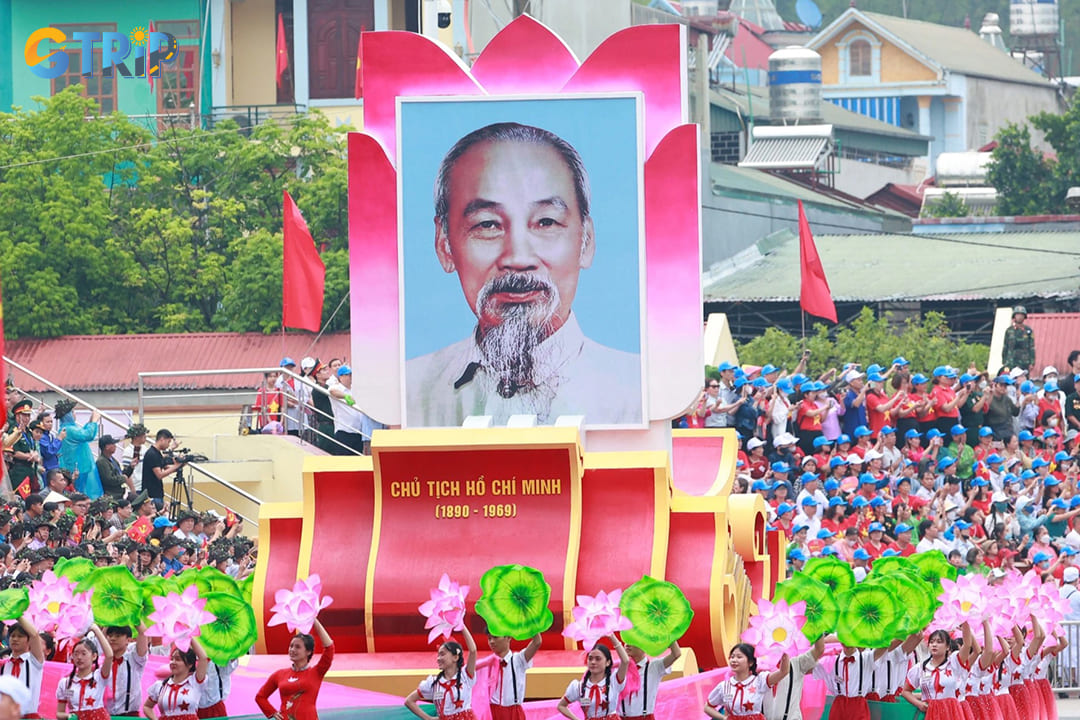
Ho Chi Minh played a central role in Vietnam’s struggle for independence and unification
Key historical timeline and events of the mausoleum
The Ho Chi Minh Mausoleum stands as one of Vietnam's most significant historical monuments, representing the nation's profound respect for their revolutionary leader. The construction and development of this iconic structure spans several years, marked by political decisions, international cooperation, and technical achievements. The mausoleum's creation reflects not just architectural achievement but also the deep emotional connection between the Vietnamese people and the man they affectionately call "Uncle Ho".
- 1969
On September 2, President Ho Chi Minh passed away at the age of 79. In his will, he asked to be cremated, with his ashes scattered across the North, Central, and South as a symbol of unity. However, the Vietnamese government, reflecting the collective wishes of the Communist Party and the people, decided to preserve his body for long-term public commemoration.
- 1970
Early in the year, discussions began between Vietnamese leaders and Soviet experts to plan the mausoleum. The Politburo officially approved the project, and Soviet specialists, drawing from their experience with Lenin’s Mausoleum, were invited to advise on design, preservation techniques, and construction logistics.
- 1971 - 1972
During these two years, the architectural design was finalized, blending traditional Vietnamese elements with Soviet monumental style. The project was assigned to the Ministry of Defense, and a dedicated engineering regiment was formed to lead construction. Ba Dinh Square was selected as the site, symbolically important as the location where Ho Chi Minh had proclaimed national independence in 1945.
- September 2, 1973
A formal groundbreaking ceremony was held on Vietnam’s National Day, exactly four years after Ho Chi Minh’s death. This marked the official start of construction.
- 1973 - 1975
Despite wartime hardships, including ongoing conflict in the south, the construction pressed forward for nearly 700 days. Thousands of Vietnamese workers and soldiers, alongside Soviet engineers and architects, collaborated to complete the structure. Advanced preservation systems were installed to protect the body from Vietnam’s hot, humid climate.
- August 29, 1975
The mausoleum was officially inaugurated, just days before what would have been Ho Chi Minh’s 85th birthday. The final structure stands 21.6 meters tall and 31 meters wide, featuring a harmonious mix of granite, marble, and traditional motifs. It became an enduring symbol of national reverence and remains one of Vietnam’s most important historical and cultural landmarks.

The Ho Chi Minh Mausoleum stands as one of Vietnam's most significant historical monuments
Architectural marvel: Design, style, and materials of the mausoleum
The Ho Chi Minh Mausoleum blends traditional Vietnamese elements with Soviet influences to create a structure that honors the nation's beloved leader while symbolizing Vietnam's cultural identity and political history. This monumental building embodies Vietnam's reverence for its revolutionary leader through carefully selected materials, thoughtful design elements, and symbolic features.
Blend of Vietnamese traditional architecture and Soviet influences
The Ho Chi Minh Mausoleum combines Soviet architectural influence with traditional Vietnamese design. Its rectangular base, grand scale, and solid materials reflect the Soviet style, inspired by Lenin’s Mausoleum in Moscow. This monumental form was chosen to symbolize strength, permanence, and the importance of the revolutionary leader.
At the same time, the mausoleum incorporates distinctly Vietnamese elements. The three-tiered sloping roof resembles ancient pagodas, and the overall proportions follow Vietnamese principles of harmony and balance. This blend creates a structure that honors Ho Chi Minh while reflecting both Vietnam’s cultural roots and historical alliances.
Design and style of mausoleum
The Ho Chi Minh Mausoleum stands as a striking monument, measuring 21.6 meters (70 ft 10 in) in height and 41.2 meters (135 ft 2 in) in width. Its three-tiered, rectangular design creates an imposing silhouette visible from Ba Dinh Square, reinforcing its significance as a national symbol and central point for ceremonies. The symmetrical design emphasizes its role as a solemn monument for the nation's leader.
The mausoleum’s triangular sloping roof is a direct homage to traditional Vietnamese pagodas and temples, creating a visual link to the country's ancient architectural heritage. This modern interpretation connects Ho Chi Minh's resting place to the cultural roots of Vietnam, reflecting both historical continuity and the evolution of Vietnamese architecture.
Elevated by a traditional three-step staircase, the mausoleum symbolizes Ho Chi Minh’s esteemed position. The use of crimson-red stones and marble pillars evokes a five-room rural Vietnamese house, a reminder of the leader's humble origins and his connection to the country's agricultural traditions.
A prominent feature of the mausoleum is the inscription "Chu tich Ho Chi Minh" in dark red jade from Ho Chi Minh's birthplace, Cao Bang. This detail strengthens the symbolic bond between the leader and his homeland. The mausoleum’s Stripped Classicism style combines simplicity and dignity, creating a space for reflection and reverence while honoring the leader's legacy.
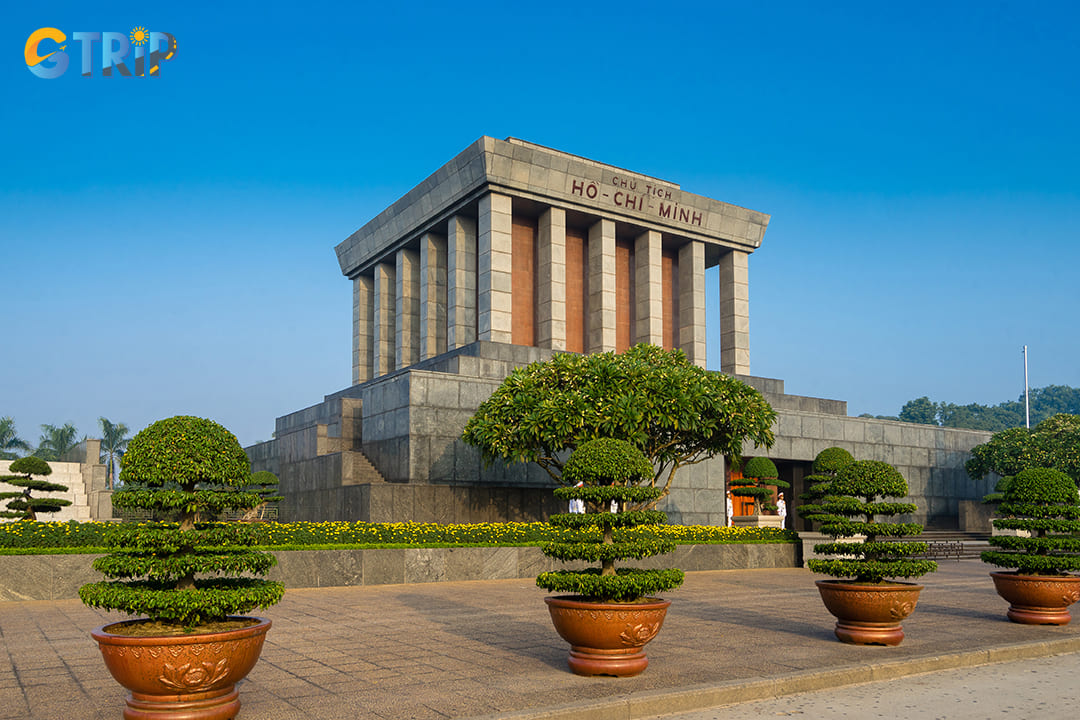
The Ho Chi Minh Mausoleum combines Soviet architectural influence with traditional Vietnamese design
Materials
The Ho Chi Minh Mausoleum uses materials rich in symbolism and built for longevity. Its exterior is clad in grey granite from various regions of Vietnam, symbolizing unity and permanence. Inside, polished stones, grey, black, red, and pink-veined marble, create a reflective and respectful atmosphere.
Woodwork crafted from native hardwoods by artisans from Nghe An, Nam Ha, and Ha Bac connects the structure to Vietnamese craftsmanship and Ho Chi Minh’s roots. Gold inlays in the lobby bear his iconic quote: “Nothing is more precious than Independence and Freedom”, highlighting the enduring value of his ideals. The entrance to the central chamber was hand-crafted by skilled woodworkers from Gia Hoa village.
Surrounding gardens further enrich the symbolism. Seventy-nine sago palms represent Ho Chi Minh’s age at death, bamboo groves evoke Vietnamese resilience, and over 18,000 m² of native ginger grass reflect the local landscape. Nearly 250 plant species showcase the nation’s biodiversity, softening the monument and grounding it in nature.
Structural and functional features
The Ho Chi Minh Mausoleum was designed not only as a national monument but also as a highly resilient structure. Engineered to withstand earthquakes up to magnitude 7, military attacks, and severe weather, it reflects the strength and endurance associated with Ho Chi Minh himself. Advanced systems manage drainage, structural integrity, and climate control, particularly in the central chamber where his embalmed body is preserved under strict conditions. These protective features ensure long-term preservation while maintaining the solemn dignity of the site.
Functionally, the mausoleum also serves as a ceremonial hub. It includes two side platforms for leaders to observe national events, while Ba Dinh Square in front is divided into 240 green squares that organize foot traffic and enhance the site’s formal presence. This layout supports large public gatherings and state ceremonies, reinforcing the mausoleum’s central role in national identity.
Inside, the main chamber holds Ho Chi Minh’s preserved body in a glass sarcophagus, watched over by an honor guard. The atmosphere is dim and reverent, allowing visitors to silently pay their respects. This space offers a powerful link between Vietnam’s revolutionary past and its present, making each visit a moment of national reflection.
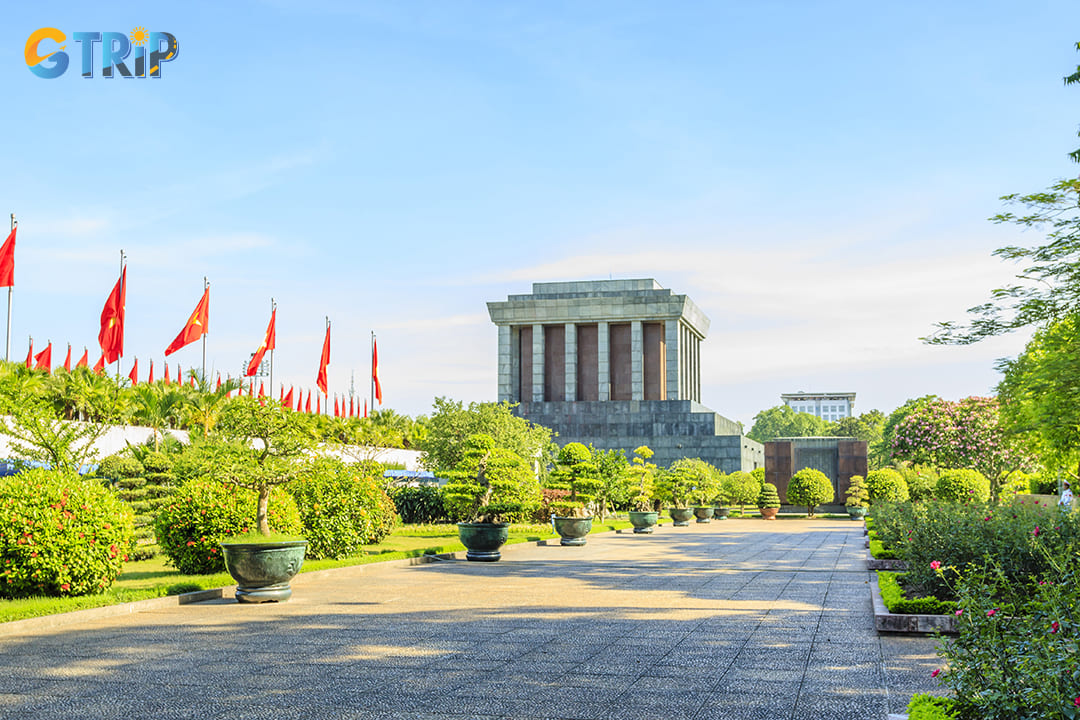
Surrounding gardens further enrich the symbolism
Must-see inside and around the mausoleum
The Ho Chi Minh Mausoleum houses numerous significant features that tell the story of Vietnam's revolutionary leader and the nation's struggle for independence. You can experience a profound connection to Vietnamese history through these carefully curated elements. Each feature has been thoughtfully designed to honor President Ho Chi Minh's legacy and the values he championed throughout his life.
Admire the flag ceremony at Ba Dinh Square
The flag ceremony at Ba Dinh Square is one of Vietnam's most solemn and patriotic daily rituals. Taking place in front of the Ho Chi Minh Mausoleum, it draws both locals and travelers to witness a powerful display of national pride. The ceremony happens twice daily: the flag is raised at 6:00 am (April - September) or 6:30 am (October - March), and lowered at 9:00 pm year-round. Each performance features a ceremonial guard of 34 soldiers, honoring the original members of Vietnam’s Propaganda Unit of Liberation Army.
The ritual unfolds with stirring martial music and a precise military procession. Soldiers march from nearby streets, carry the flag to a 29-meter pole, and raise it as the national anthem plays. In the evening, the flag is lowered and folded with equal care. The atmosphere is respectful and still, especially on major holidays like National Day (September 2) and Ho Chi Minh’s birthday (May 19). Ba Dinh Square’s historic role adds deep meaning to the ceremony, especially during commemorative events when the flag remains raised throughout the day.

The flag ceremony at Ba Dinh Square is one of Vietnam's most solemn and patriotic daily rituals
Changing of the guard ceremony
The changing of the guard at the Ho Chi Minh Mausoleum takes place hourly, offering multiple chances to witness this disciplined military tradition. Clad in crisp white uniforms, the honor guards perform a silent, precise exchange that reflects the nation's respect for Ho Chi Minh’s legacy. As new guards approach in synchronized formation, they seamlessly replace their predecessors through a choreographed sequence. Despite constant visitors, the guards remain composed and focused. Though photography is limited to outside areas, the ceremony offers excellent moments for observation near the main entrance. Its quiet precision conveys a sense of dignity and national pride without elaborate display.
Central Hall with Ho Chi Minh's embalmed body in a glass sarcophagus
The central hall of the Ho Chi Minh Mausoleum houses the embalmed body of the Vietnamese leader, resting in a glass sarcophagus. Though Ho Chi Minh wished to be cremated, the government chose to preserve his body as a national symbol, with help from Russian experts. His remains are meticulously maintained, including during the mausoleum’s annual closure for upkeep.
The chamber's design evokes solemnity and reverence. Gray marble walls and dim lighting create a subdued atmosphere, drawing attention to the raised sarcophagus. Ho Chi Minh is dressed in his iconic tan suit, lying in still dignity under constant guard by four silent honor soldiers. Visitors move slowly and silently through the room in single file, guided by security personnel. For many, the experience is deeply emotional, especially for Vietnamese who see him as the founding father, and for others, a powerful moment of reflection.
Lobby with the inscription "Nothing is more precious than Independence and Freedom"
Before reaching the central chamber, you enter a solemn lobby where a powerful inscription reads: "Khong co gi quy hon Doc lap Tu do" ("Nothing is more precious than Independence and Freedom"). Taken from Ho Chi Minh’s own words, this declaration captures the essence of Vietnam’s long struggle for independence and remains a central pillar of the country’s national identity.
The inscription spans a polished marble wall, presented in bold, dignified script that commands immediate attention. The lobby’s high ceilings and austere marble surfaces enhance the sense of reverence, creating a quiet, contemplative space. It acts as a psychological and emotional threshold, setting the tone for what lies ahead in the central chamber where Ho Chi Minh rests.
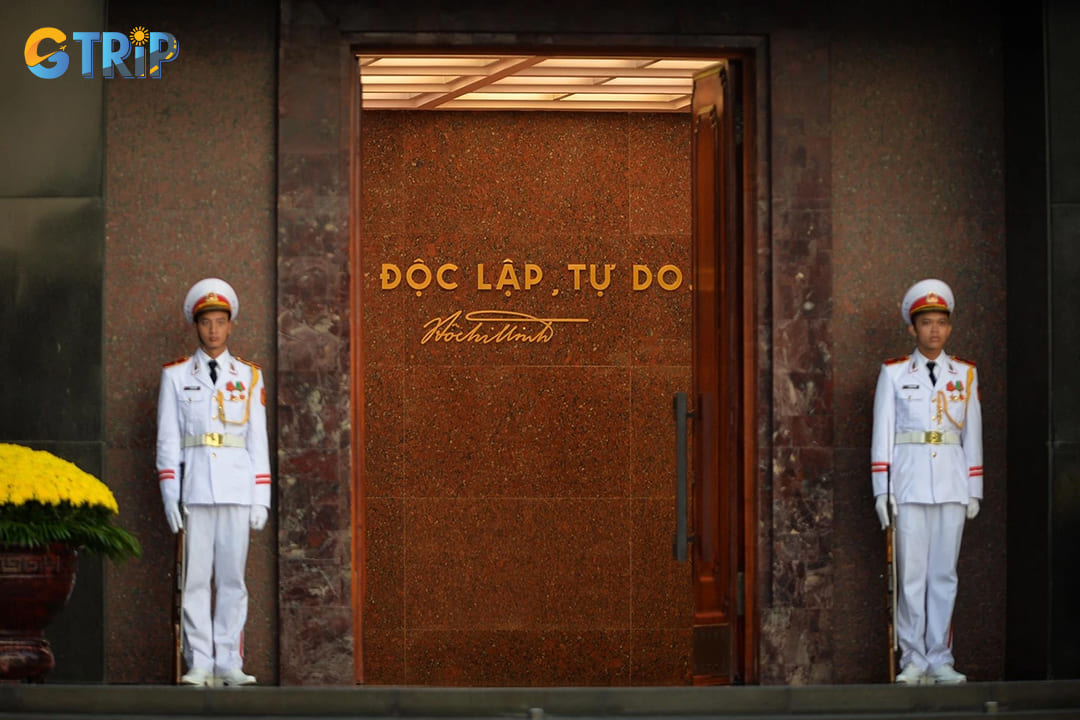
The inscription spans a polished marble wall, presented in bold, dignified script that commands immediate attention
Ho Chi Minh's gold-plated signature
Directly beneath the independence inscription in the mausoleum lobby, visitors encounter Ho Chi Minh’s signature in gold inlay set against dark stone. This striking detail visually links the leader to the powerful words above, reinforcing his personal commitment to the ideals of independence and freedom.
The signature, rendered exactly as it appeared on official documents, is simple and unadorned, reflecting Ho Chi Minh’s humility. The choice of gold conveys the enduring value of his legacy, while the dark stone backdrop ensures a quiet elegance. For many Vietnamese, this signature feels deeply personal, like a lasting imprint of the man behind the movement.
Surrounding gardens with over 250 plant species from different regions of Vietnam
The mausoleum's exterior is framed by beautifully maintained gardens that blend aesthetics with symbolic meaning. Featuring more than 250 plant species from across Vietnam, the gardens honor the diverse regions connected to Ho Chi Minh’s life and revolutionary path. Each species was chosen for both visual harmony and regional significance, creating a living tribute to national unity.
The garden design draws from traditional Vietnamese landscaping, with defined zones reflecting key geographic areas. The northern section features flora from mountainous provinces tied to the early revolution. The central zone highlights plants from Ho Chi Minh’s birthplace in Nghe An, and the southern section includes tropical species symbolizing national reunification. A peaceful meditation garden offers benches and shaded paths, inviting quiet reflection in the midst of a solemn national site.

The mausoleum's exterior is framed by beautifully maintained gardens that blend aesthetics with symbolic meaning
When is the best time to visit the Ho Chi Minh Mausoleum?
Timing is everything when planning a visit to the iconic Ho Chi Minh Mausoleum in Hanoi. This solemn landmark follows specific operational schedules that vary throughout the year, with particular considerations for weather, crowds, and periodic maintenance closures.
Best time of day to visit the mausoleum
Visiting the Ho Chi Minh Mausoleum early in the morning ensures a smoother and more rewarding experience. With the site open only in the mornings, arriving before 9:00 AM helps avoid the long lines that often build later in the day, especially during weekends or national holidays. Cooler temperatures also make the early hours more comfortable, particularly in Hanoi’s hot and humid summer months.
Photography enthusiasts will appreciate the soft morning light, which enhances the mausoleum’s granite structure and the surrounding Ba Dinh Square gardens. Early risers can also witness the daily flag-raising ceremony, held at 6:00 AM in summer and 6:30 AM in winter, featuring a full military honor guard. The mausoleum opens from 7:30 to 10:30 AM in summer and 8:00 to 11:00 AM in winter, with extended hours until noon on weekends. It remains closed on Mondays and Fridays, and the last entry is typically 30 minutes before closing.
Best time of year to visit the mausoleum
Hanoi's seasonal shifts play a key role in shaping the experience at the Ho Chi Minh Mausoleum. From November to April, the weather is cool and dry, with temperatures ranging between 15-25°C. This period offers the most comfortable conditions for standing in outdoor queues and exploring the broader complex. December to February are the coolest months, though visitor numbers often spike during the Lunar New Year (Tet), which usually falls between late January and mid-February.
From May to October, temperatures rise significantly (28-36°C), and heavy rains, especially in July and August, can disrupt outdoor plans. Humidity levels soar, and afternoon downpours are common. While crowds thin during these months, September often sees the mausoleum temporarily closed for annual maintenance. October brings more stable weather, but it's best to check the schedule in advance. To avoid large crowds, plan your visit for a weekday morning, ideally outside national holidays and international peak travel periods like December-January and July-August.
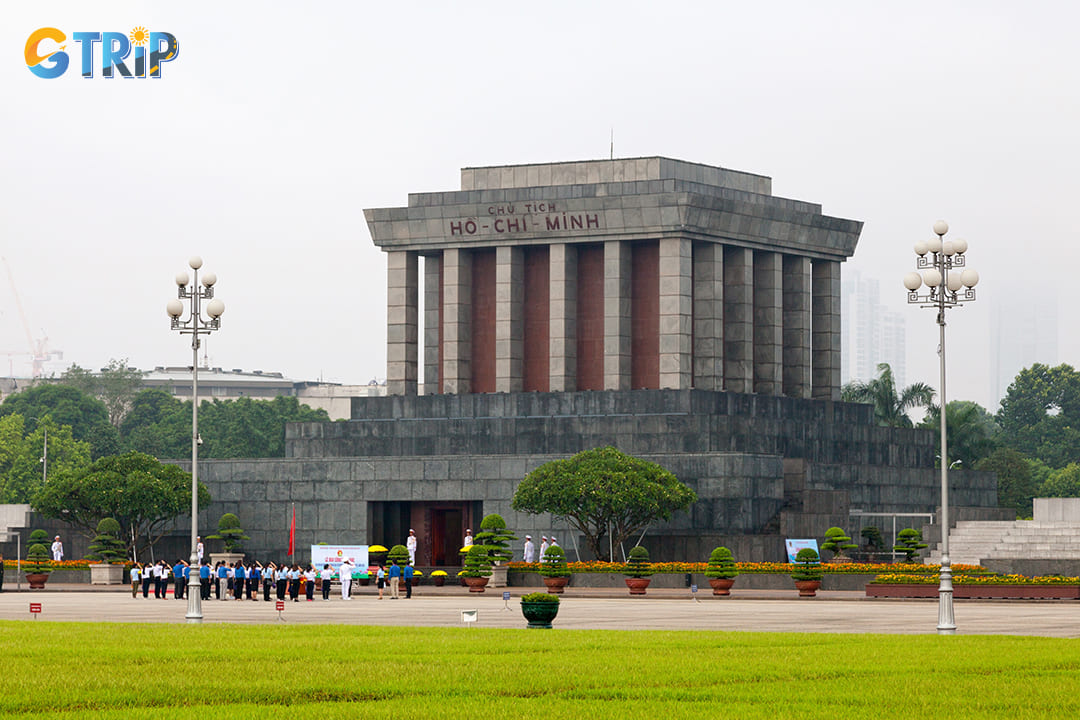
Visiting the Ho Chi Minh Mausoleum early in the morning ensures a smoother and more rewarding experience
Maintenance time of Ho Chi Minh Mausoleum
The Ho Chi Minh Mausoleum undergoes annual maintenance, typically from September to November, with October being the most consistent month for closure. While the mausoleum is closed, the surrounding Ba Dinh complex, Ho Chi Minh Museum, and nearby gardens remain accessible. You can still photograph the mausoleum’s exterior, though only from a distance. If traveling during this period, check the mausoleum’s official website or ask your hotel for the current status, and consider alternative historical sites like Hoa Lo Prison or the Vietnam Military History Museum. To avoid disappointment, those with flexible travel dates should plan their Hanoi visit outside the maintenance period, or schedule it at the start or end of their Vietnam trip in case adjustments are needed.
How to get to the Ho Chi Minh Mausoleum
Navigating your way to the Ho Chi Minh Mausoleum is relatively straightforward, as this iconic landmark sits prominently in Hanoi's Ba Dinh District.
By taxi or ride-hailing app
Taking a taxi or ride-hailing service is the easiest and most convenient way to reach the Ho Chi Minh Mausoleum, especially for newcomers to Hanoi. These options offer door-to-door service and remove the stress of navigating unfamiliar streets.
Simply tell the driver "Lang Chu tich Ho Chi Minh" or show the address: 1 Hung Vuong, Dien Bien, Ba Dinh, Ha Noi. Popular ride-hailing apps like Grab, Be, Mai Linh Taxi, and Xanh SM are widely used and reliable.
Fares from central locations are affordable: around 40,000-70,000 VND from the Old Quarter, 50,000 - 80,000 VND from Hanoi Railway Station, and 300,000 - 400,000 VND from Noi Bai Airport. Travel times range from 10 minutes to an hour, depending on distance and traffic, with morning and evening rush hours causing potential delays.
By bus
Public buses are the most budget-friendly way to reach the Ho Chi Minh Mausoleum, with several routes stopping near Ba Dinh Square. Key options include bus numbers 09, 18, and 22, all of which drop you within a 3 - 5 minute walk of the site. Fares range from just 7,000 to 10,000 VND per trip (around $0.30 - $0.45), making buses ideal for cost-conscious travelers. Most routes run from 5:00 AM to 9:00 PM with buses every 10 - 20 minutes during the day.
By walking or by bicycle
Walking or biking to the Ho Chi Minh Mausoleum is a scenic and engaging option for travelers based in central Hanoi. From the Old Quarter, it’s a 25-35 minute walk (around 2 km), passing iconic sights like St. Joseph’s Cathedral and Lenin Park along the way.
Cycling is also popular, with rentals available from hotels or bike shops for 50,000 - 100,000 VND per day. Public bike-sharing is available via the "S-bike" system, though registration is required. When cycling, stay alert in Hanoi’s dense traffic, use hand signals, and wear a helmet. Bike parking is available near the mausoleum.

You can reach the Ho Chi Minh Mausoleum by many transportation
Tips for visitors when visiting the Ho Chi Minh Mausoleum
Visiting Ho Chi Minh's final resting place is a solemn experience that requires respectful conduct. This national site is not a regular tourist attraction but a deeply revered space for the Vietnamese people.
Dress code
Modest attire is mandatory. Wear clothing that covers your shoulders and knees. Acceptable items include:
- Long pants or skirts
- Shirts with sleeves
- Closed or open-toed shoes
Avoid shorts, mini-skirts, sleeveless tops, low-cut garments, or see-through clothing. Security strictly enforces these rules. Bring a light jacket or shawl if visiting during summer. Hats and sunglasses must be removed before entering.
Prohibited items
The mausoleum enforces strict security:
- No cameras, phones, or recording devices
- No bags, food, drinks, lighters, umbrellas, or sharp objects
Storage lockers are available near the entrance. Bring only essentials and leave valuables behind. Strollers must also be checked.
Behavior and etiquette
Visitors must maintain a quiet, respectful demeanor. Inside the mausoleum:
- Silence is required
- No photos or gestures
- Walk slowly in two lines
- Keep arms at sides, hands visible
No gum, eating, drinking, or smoking. Avoid physical contact or disruptive behavior. Follow guard instructions without question. The viewing lasts about 30 seconds but holds deep meaning for many Vietnamese people.
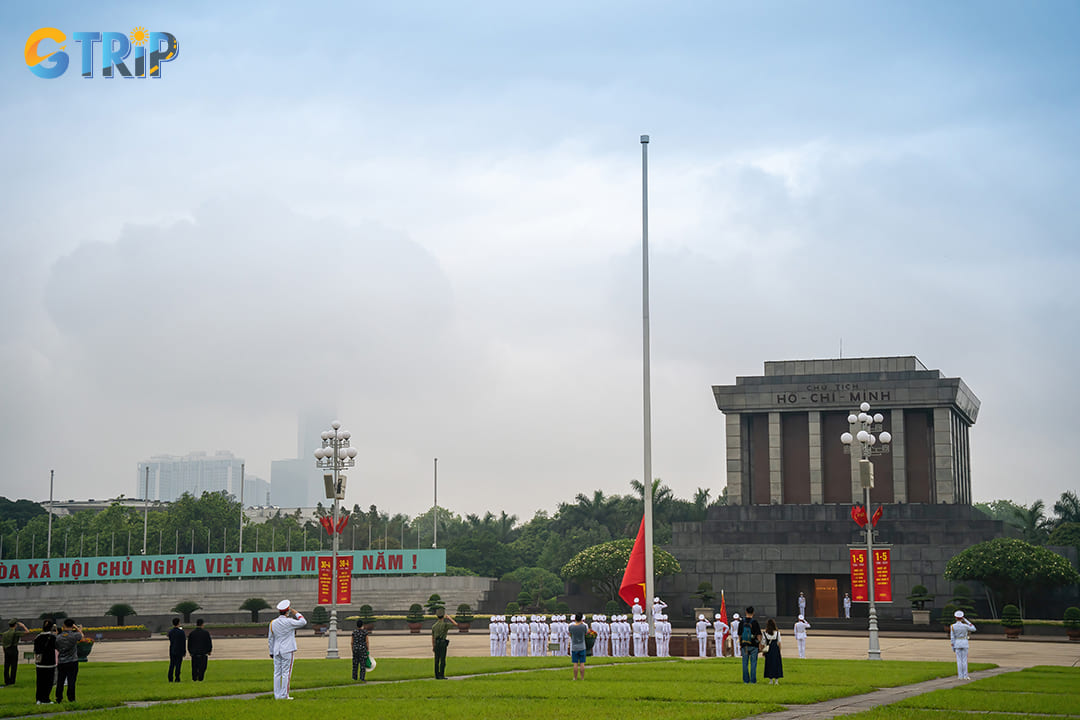
Visiting Ho Chi Minh's final resting place is a solemn experience that requires respectful conduct
Other nearby attractions from the Ho Chi Minh Mausoleum
The Ho Chi Minh Mausoleum is surrounded by several important landmarks that offer visitors a deeper dive into Vietnam’s history and culture. Located within walking distance of the mausoleum, these sites make for an enriching and comprehensive cultural experience.
One Pillar Pagoda (300m)
Just a 5-minute walk from the Ho Chi Minh Mausoleum, the One Pillar Pagoda is one of Vietnam’s most iconic architectural landmarks. Built in 1049 during the Ly Dynasty, it is designed to resemble a lotus flower rising from the water, symbolizing purity and enlightenment. The original structure was destroyed during the French occupation in 1954, but was faithfully reconstructed. A visit to the pagoda typically takes 15-20 minutes, offering visitors a chance to admire its unique design, serene pond, and cultural significance. It is especially meaningful for those seeking blessings for fertility and health.
Ho Chi Minh Museum (60m)
Located just steps away from the mausoleum, the Ho Chi Minh Museum offers a deeper look into the life and legacy of Vietnam's revered leader. Opened in 1990 to commemorate his 100th birthday, this modernist building houses over 20,000 artifacts and exhibits documenting Ho Chi Minh's revolutionary journey. The museum blends historical artifacts with contemporary art, offering a multidimensional understanding of his philosophy and global impact. A comprehensive visit generally takes 1-2 hours, with English descriptions available throughout most of the exhibits.
Ho Chi Minh's Stilt House (1km)
Located 1km from the mausoleum, Ho Chi Minh’s stilt house offers insight into his simple lifestyle. Despite being the country’s most influential figure, he chose to live in this two-room structure from 1958 until his death in 1969. The house is preserved to reflect his humble values, with a wooden desk where he worked on state matters and gardens he personally tended. You can also explore the surrounding peaceful garden and fish pond, making for a tranquil break from the busy city.
Presidential Palace (800m)
The Presidential Palace, located 800 meters from the mausoleum, is an impressive French colonial building, designed by architect Auguste Henri Vildieu between 1900 and 1906. It was intended to house the French Governor-General of Indochina. After Vietnam's independence, Ho Chi Minh rejected this symbol of colonialism and chose to live in his modest stilt house nearby. Though you cannot enter the palace, they can enjoy its striking exterior and explore its beautifully landscaped gardens, ceremonial grounds, and the historic Mango Alley. A visit to the grounds typically takes 30-45 minutes, providing a stark contrast between colonial opulence and revolutionary simplicity.
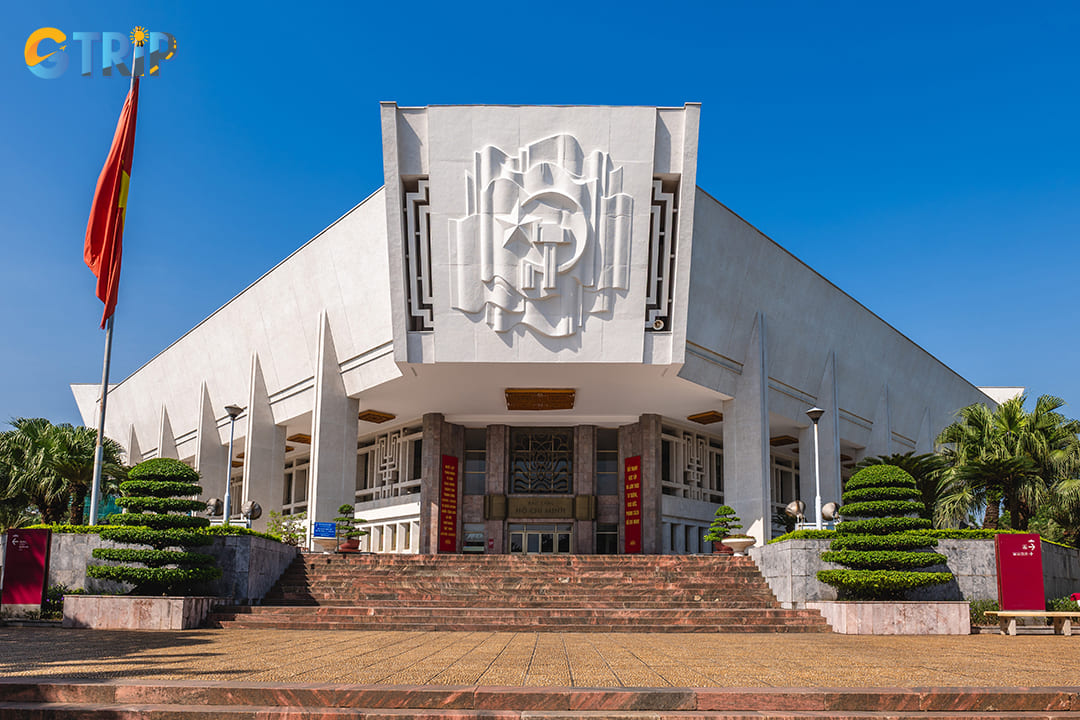
Located just steps away from the mausoleum, the Ho Chi Minh Museum offers a deeper look into the life and legacy of Vietnam's revered leader
Visiting the Ho Chi Minh Mausoleum is a deeply moving experience that connects you to Vietnam's history and the enduring legacy of its beloved leader. It offers valuable insights into the values that shaped modern Vietnam. This visit enriches your journey with reflection and understanding, inspiring a broader perspective of the world and the importance of travel. If you are interested in visiting this mausoleum or any attractions in Hanoi, consider booking Hanoi Tours from GTrip - Vietnam Travel Agency. We offer curated tours and professional tour guides to support you in having the best journey exploring Hanoi in Vietnam.

